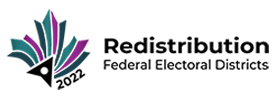Addendum to the Report – Disposition of Objections – Saskatchewan
Introduction
The Federal Electoral Boundaries Commission for the Province of Saskatchewan (the Commission) received three objections to its Report, dated December 2, 2022, for consideration. The objections are outlined in the 28th Report of the Standing Committee on Procedure and House Affairs, 44th Parliament, First Session. They were transmitted to the Commission by the Chief Electoral Officer on March 23, 2023. The Commission is required by the Electoral Boundaries Readjustment Act to consider and dispose of these objections as well as to return its disposition and any amendments to its Report by April 22, 2023.
The Standing Committee stated in its report that three objections had been received from members of Parliament. The Standing Committee chose to forward all of the objections to the Commission. There was a dissenting opinion with respect to one of the objections.
The Commission has now had the opportunity to meet and consider the three objections submitted to it. The following addendum provides the Commission's decisions regarding each of these objections and the resulting amendments in this addendum to its Report.
Objections
1) In favour of creating a central urban riding in Saskatoon
The rationale for the objection is to provide better advocacy and representation that focuses on the urban experience. It is suggested by the objection that the Report joined different communities of interest with different infrastructure needs with the implication that such communities should be in different ridings. It was on this point that the Standing Committee was divided. The majority of the Standing Committee supported the objection and the minority did not.
For the reasons stated in its Report, the Commission was and still is of the opinion that a central urban riding in Saskatoon is not appropriate at this time.
2) In favour of modifying the boundary between Regina—Lewvan and Regina—Qu'Appelle
The suggested change to this riding is to exchange one part of Regina—Lewvan with another part of Regina—Qu'Appelle. The Standing Committee's report referred to each of these two parcels as having 5,771 and 5,275 constituents respectively. It was suggested by the objection that the boundaries as set out in the Report divided communities of interest which would be better represented by exchanging these two neighbourhoods. The population, according to the 2021 Census, corresponding to the map accompanying the objection is in fact 8,040 (Regina—Lewvan) and 6,959 (Regina—Qu'Appelle).
The Commission agrees with this objection. These two neighbourhoods should be exchanged. Table 1, the accompanying maps and descriptions shall be adjusted accordingly.
3) In favour of keeping Wynyard and Ituna in the proposed riding of Regina—Qu'Appelle
The objection asks that Wynyard and Ituna and the associated rural municipalities be kept within the riding of Regina—Qu'Appelle where they have been for a long period of time. Taking into account the reduced population of Regina—Qu'Appelle by virtue of the acceptance of the change mentioned in the second objection, the consequence of adding these municipalities to that riding and subtracting them from Yorkton—Melville will have a minor effect on the electoral quotas of Regina—Qu'Appelle and Yorkton—Melville. Importantly, the population of Regina—Qu'Appelle will still be in line with that of the other five urban ridings even with this change.
The Commission agrees with this objection. Table 1, the accompanying maps and descriptions shall be adjusted accordingly.
Summary
The Commission has accepted two of the objections received from the Standing Committee and amends its Report accordingly.
The following table reflects the numeric change to the ridings of Regina—Lewvan, Regina—Qu'Appelle and Yorkton—Melville as a result of accepting the objections in this Addendum:
| Federal Electoral District | Population | Variation from Electoral Quota (80,893) | Variation from Reference Quota (84,205) | Area (km2) |
|---|---|---|---|---|
| Regina—Lewvan | 86,899 | +7.43% | +3.20% | 85 |
| Regina—Qu'Appelle | 89,275 | +10.37% | +6.03% | 12,860 |
| Yorkton—Melville | 73,189 | -9.52% | -13.08% | 48,176 |
The revised maps and the descriptions of the electoral districts are contained in the following pages. Table 1, which appears at page 9 of the Report, will be replaced with a revised Table 1, as shown below. It shows Saskatchewan's 14 districts, the population of each, the percentage by which the population departs from the electoral quota in each district, the percentage by which the population departs from the "reference quota" and the territorial size of each district. This is the final table.
| Federal Electoral District | Population | Variation from Electoral Quota 80,893 | Variation from Reference Quota (Excluding Population of Northern District) 84,205 | Area (km2) |
|---|---|---|---|---|
| Desnethé—Missinippi—Churchill River (extraordinary circumstances) | 37,845 | -53.22% | -55.06% | 326,256 |
| Battlefords—Lloydminster—Meadow Lake | 83,248 | 2.91% | -1.14% | 37,373 |
| Prince Albert | 88,521 | 9.43% | 5.13% | 28,622 |
| Carlton Trail—Eagle Creek | 84,111 | 3.98% | -0.11% | 24,758 |
| Saskatoon West | 87,865 | 8.62% | 4.35% | 111 |
| Saskatoon—University | 88,714 | 9.67% | 5.35% | 72 |
| Saskatoon South | 89,562 | 10.72% | 6.36% | 54 |
| Moose Jaw—Lake Centre—Lanigan | 83,319 | 3.00% | -1.05% | 41,483 |
| Regina—Qu'Appelle | 89,275 | 10.37% | 6.03% | 12,860 |
| Regina—Lewvan | 86,899 | 7.43% | 3.20% | 85 |
| Regina—Wascana | 89,063 | 10.10% | 5.77% | 54 |
| Yorkton—Melville | 73,189 | -9.52% | -13.08% | 48,176 |
| Swift Current—Grasslands—Kindersley | 75,686 | -6.44% | -10.12% | 83,430 |
| Souris—Moose Mountain | 75,208 | -7.03% | -10.68% | 48,872 |
| Total | 1,132,505 | 652,206 |
Respectfully submitted and dated at our respective locations, in the Province of Saskatchewan, this 20th day of April, 2023.
The Honourable Justice Georgina Jackson, Chair
Bonita Beatty, Member
Mark Carter, Member
Federal Electoral Boundaries Commission for the Province of Saskatchewan
